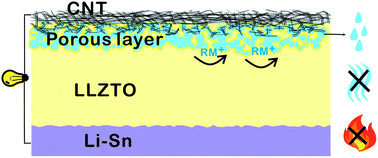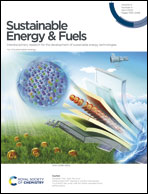A porous framework infiltrating Li–O2 battery: a low-resistance and high-safety system†
Abstract
Li–O2 batteries, which have attracted great attention because of their high energy density, suffer from issues such as flammability of organic liquid electrolytes, corrosion of the Li anode and the shuttling effect of redox mediators. Using inorganic solid-state electrolytes (SSEs) can solve such issues. But high resistance at the SSE–electrode interfaces in these batteries hinders their further development. In this study, a “porous framework infiltrating (PFI)” concept is proposed. The framework is created on the surface of a garnet Li6.4La3Zr1.4Ta0.6O12 (LLZTO) ceramic by acid etching. After infiltrating a tiny amount of liquid electrolyte, this framework exhibits nonflammability and is thus ideal for high-safety applications. Moreover, the porous structure increases the contact area between the SSE and cathode, which can lower the interfacial resistance and improve the rate capability. Utilizing a Li–Sn alloy anode, the PFI Li–O2 battery exhibits smooth charging platforms with different rates, a prolonged cycle life and a promising round-trip efficiency. Therefore, the PFI structure provides a new strategy to build safe and high-performance Li–O2 batteries.



 Please wait while we load your content...
Please wait while we load your content...